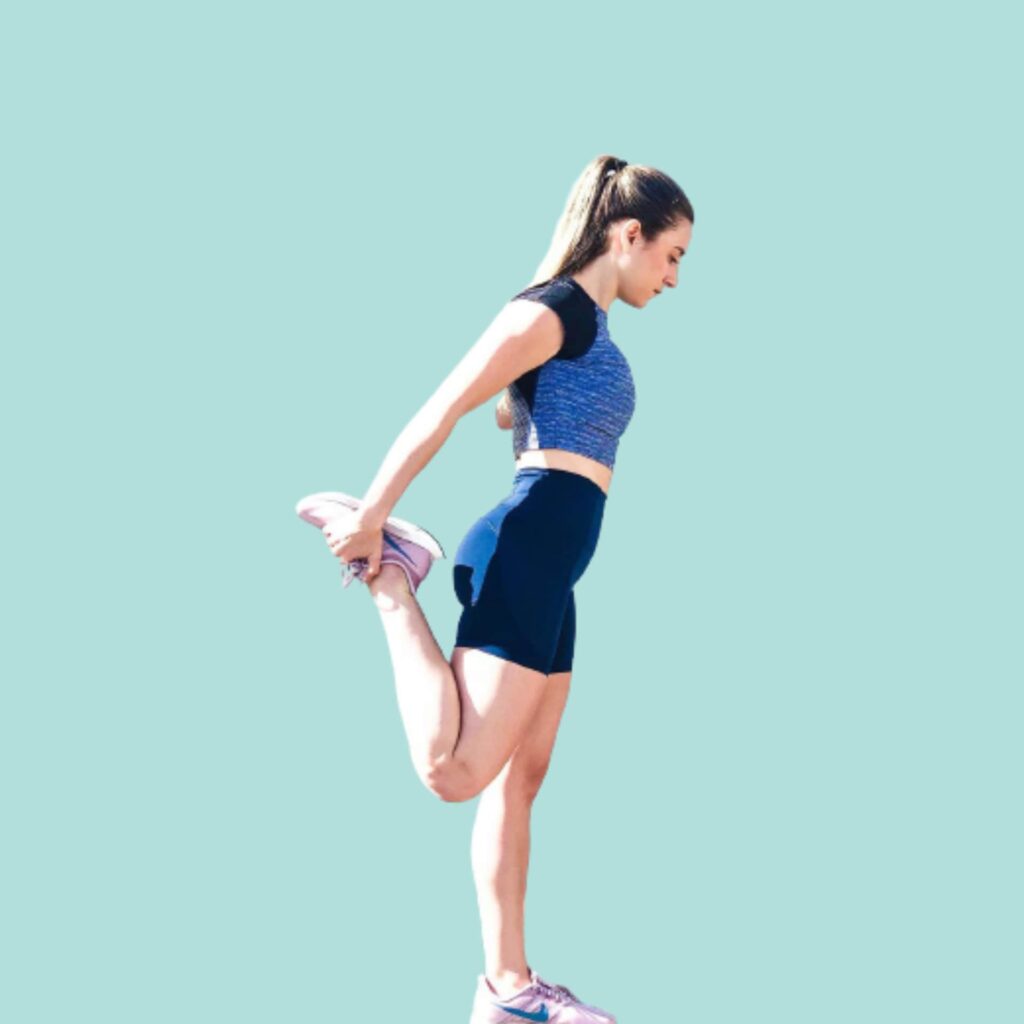Stretching exercises are important for many different reasons – to enhance flexibility, reduce muscle fatigue and sports performance, reduce injury risk, improve posture, prevent muscle soreness and breakdown. When exercising, your muscles are shortened by the constant contraction you are performing, so stretching exercises returns them to their original length.
Coming from an athletic background, I have been trained to do a small warm-up and a lot of dynamic stretching exercises before every workout. I am able to warm up the body with 8 minutes of steady state cardio and light moves of my upcoming workout, which is enough to accommodate the demands of my body’s exercises.
Top 13 Stretching Exercises
- Arm crossover shoulder stretch
- Upper back stretch
- Lateral neck stretch
- Reach back chest stretch
- Forward fold hold
- Standing quad stretch (left and right)
- Kneeling groin stretch (left and right stretch)
- Low lunge (left and right)
- Downward dog pose
- Upward dog pose
- Pigeon pose (left and right)
- Child’s pose (left and right stretch)
- Head to knee (right, centre and left)
Step by step instructions for each stretching exercise
It takes me 10–15 minutes to stretch my muscles after a workout, because stretching is a great feel-good after exercises. A good full body stretching routine is key to getting stronger and expanding range of motion. The following exercises will help you move better by increasing your flexibility. Think of slow control and deep breathing in each movement.
Keynote: Hold each stretch for 15–30 seconds.
1. Arm crossover shoulder stretch
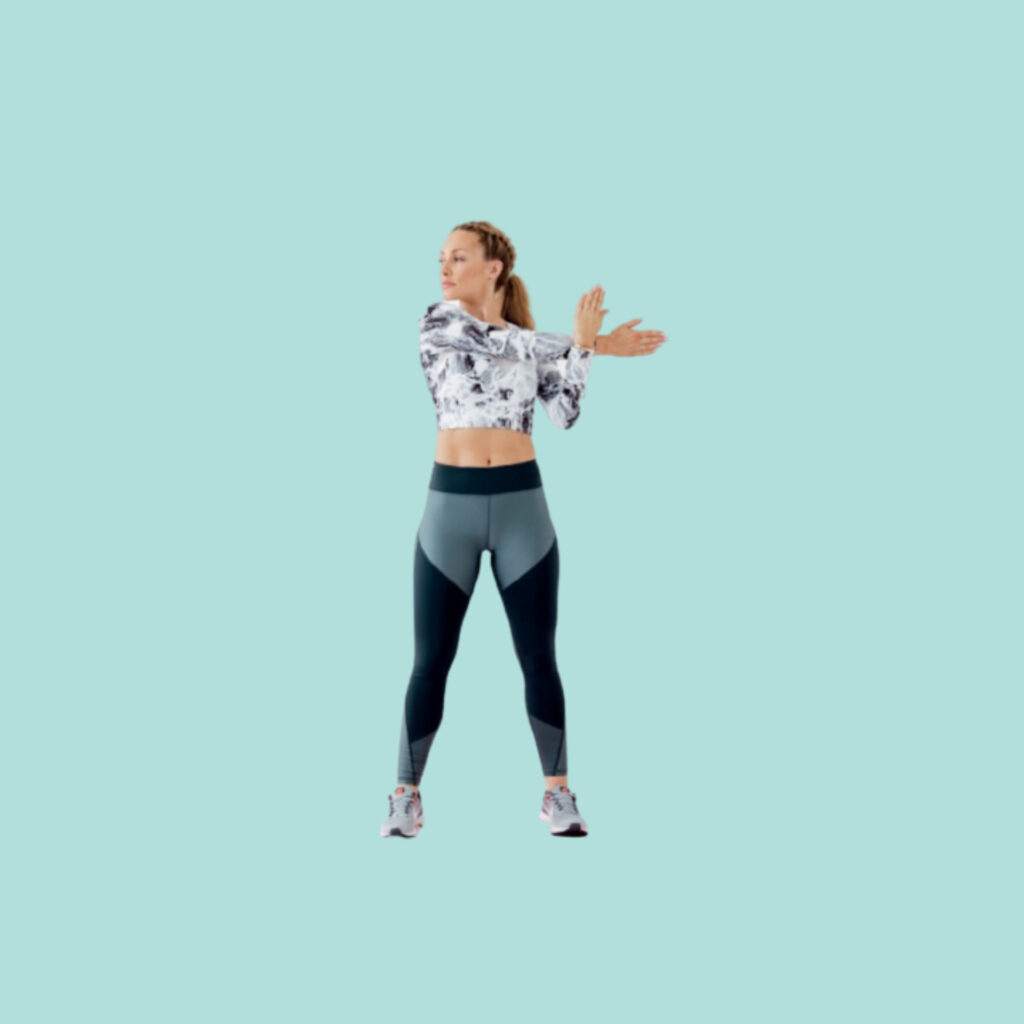
Arm crossover shoulder stretch targets the rotator cuff muscles and increased flexibility in the shoulders. This is a general inclusion in upper-body dynamic warm-up before training or sports, but can be performed anytime to “limber up” the upper body.
Stretches the shoulder muscles, including deltoid (the main muscles to work: posterior deltoid), teris minor and supraspinatus. You should feel this stretch behind your shoulder.
How to do:
- Start standing and keep your feet shoulder-width apart. Relax your shoulders and bring your right arm across your body to your left hand side, keeping it straight at all times.
- Fold your left hand over your right hand and pull against your right hand.Hold. Repeat on the opposite side.
- Do not squeeze or pressurize your elbow.
2. Upper backstretch
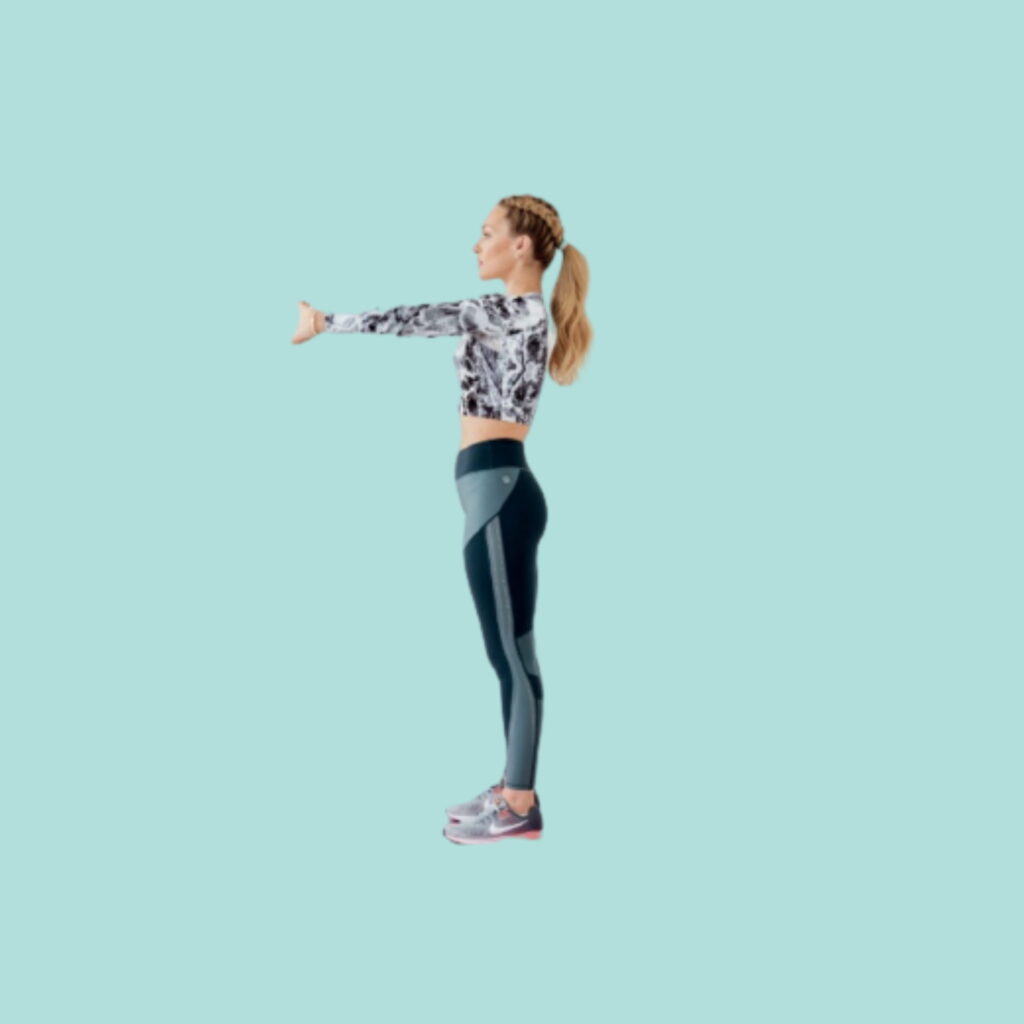
The Upper back stretch opens, stretches and extends the upper back for a healthy body. Use this pose to counter the effects of daily life and relieve pain and stiffness in your upper back.
How to do:
- Start standing in the mountain pose and spread your legs shoulder-width apart. Clasp your hands together in front of you, keep your arms straight and extend them to shoulder height.
- Keep the torso tall and push the stretch forward through your upper back.
- Hold 30 seconds and repeat.
3. Lateral neck stretch
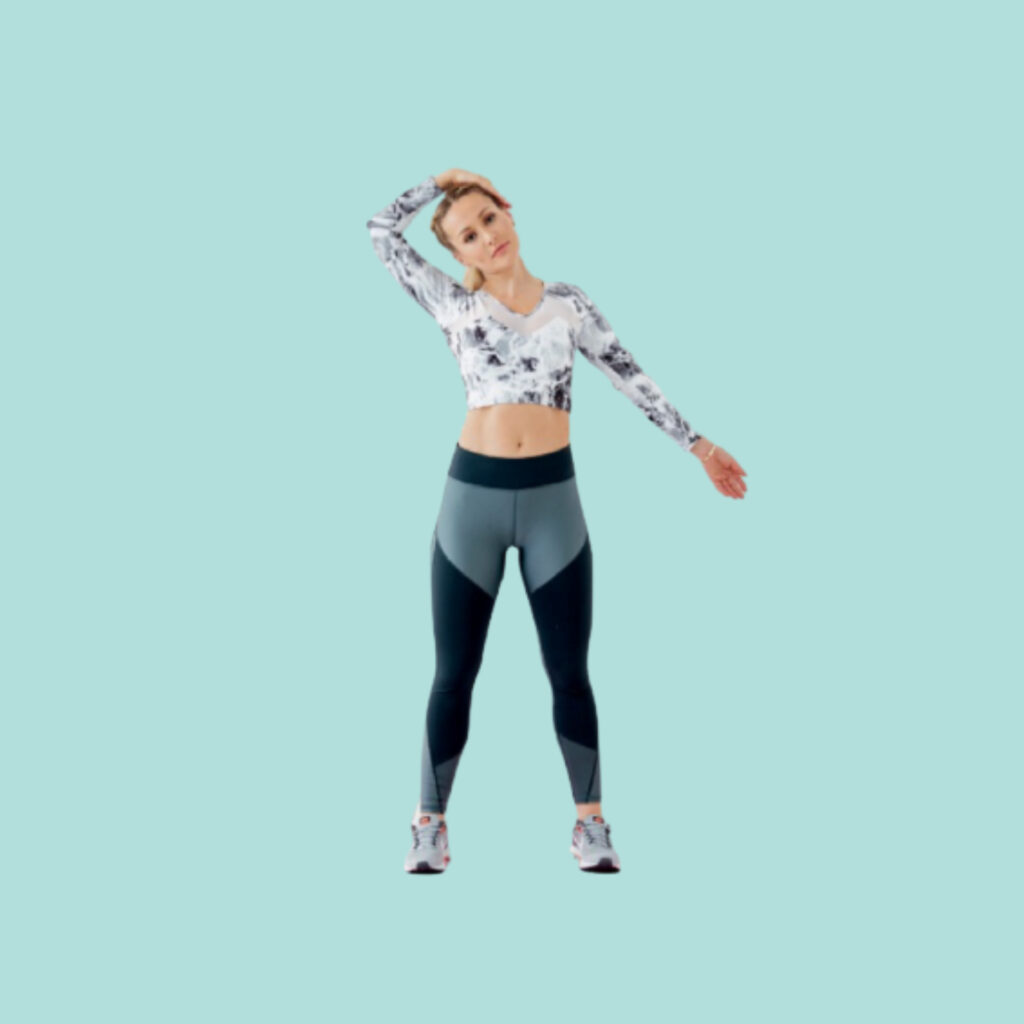
Get relief from carpal tunnel pain with lateral neck stretch exercise. Lateral neck stretch exercise builds strength, increases range of motion and relieves pain in your neck and upper back. You can do this exercise sitting or standing.
How to do:
- Start standing in the mountain pose and spread your feet shoulder-width apart. Bring your right arm over the top of the head and rest the palm against your left hand side of your head. Keep left arm out straight.
- Generating resistance with your neck, push right hand against your face so that you can feel the stretch.
- Hold this position 15 seconds and repeat on the opposite side.
SAFETY TIP: Use slow, controlled movements and avoid forcing any movement. While shaking your neck, keep the rest of your body still to maintain correct alignment and posture.
4. Reach back chest stretch
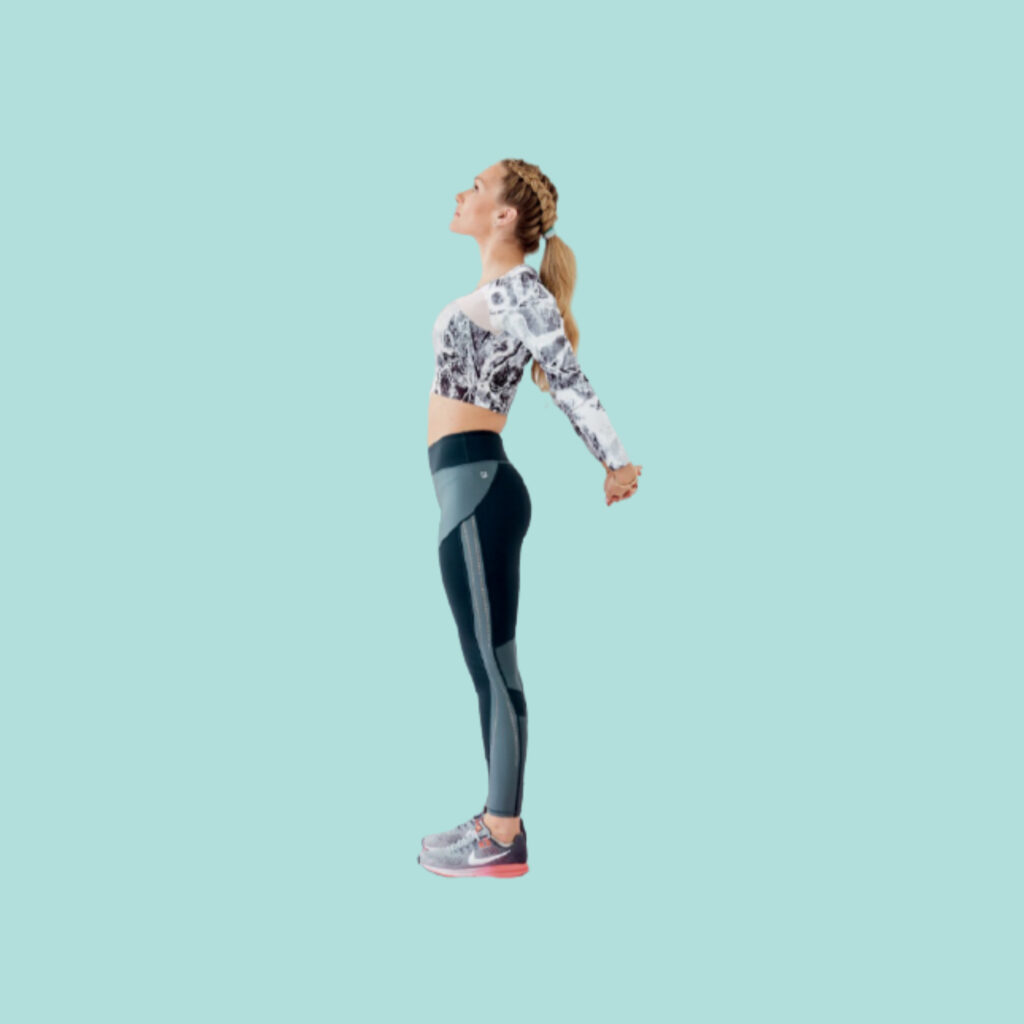
The Reach back chest stretch provide various ways to open the front body, and can be done at any time – not after a workout. Performed regularly, you will begin to see and feel a steady improvement in chest and shoulder flexibility and range of motion.
How to do:
- Start in a standing position (mountain pose), with your feet just under shoulder-width apart.
- Bring your arms back behind the back and clasp your hands together. While keeping your arms straight, pull them backwards and push the sternum forwards and slightly towards the ceiling.
- Hold 15-30 seconds or 3-5 breath cycles (1 inhale + 1 exhale = 1 breath cycle), release and repeat.
5. Forward fold hold
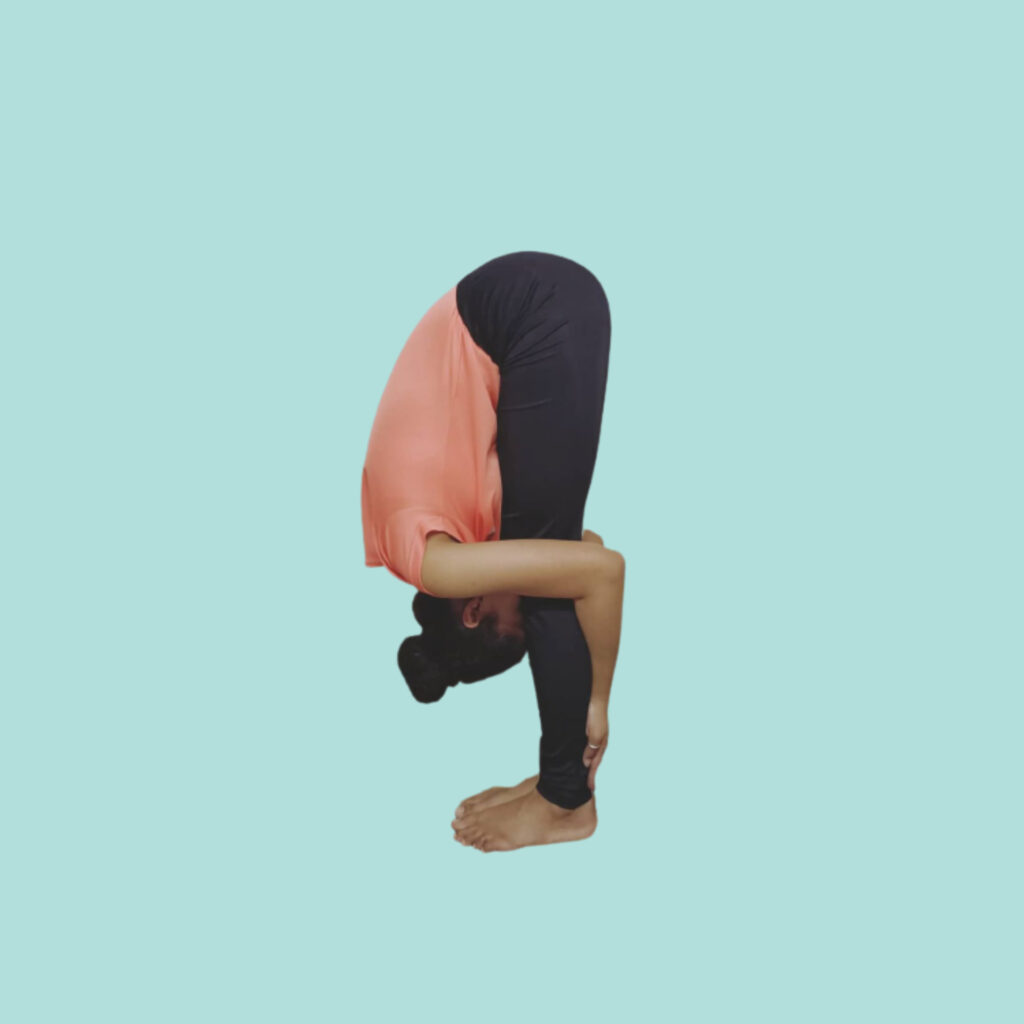
Forward fold hold extends and lengthens hamstrings and calves. If you run or play a sport that involves a lot of running, it is common to have tight hamstrings. It is considered as a relaxing and stress relieving posture. Traditionally, it is said to help relieve insomnia.
How to do:
- Stand with the feet slightly narrower than shoulder-width apart.
- Exhale and hinge forward from hips. You might need to bend your knees a little to bring palms around your ankles.
- Continue to bend and if possible press the forehead against your knees.
- Hold position 10-15 seconds. Inhale as you release and bend further from your knees if necessary.
6. Standing quad stretch (left and right)
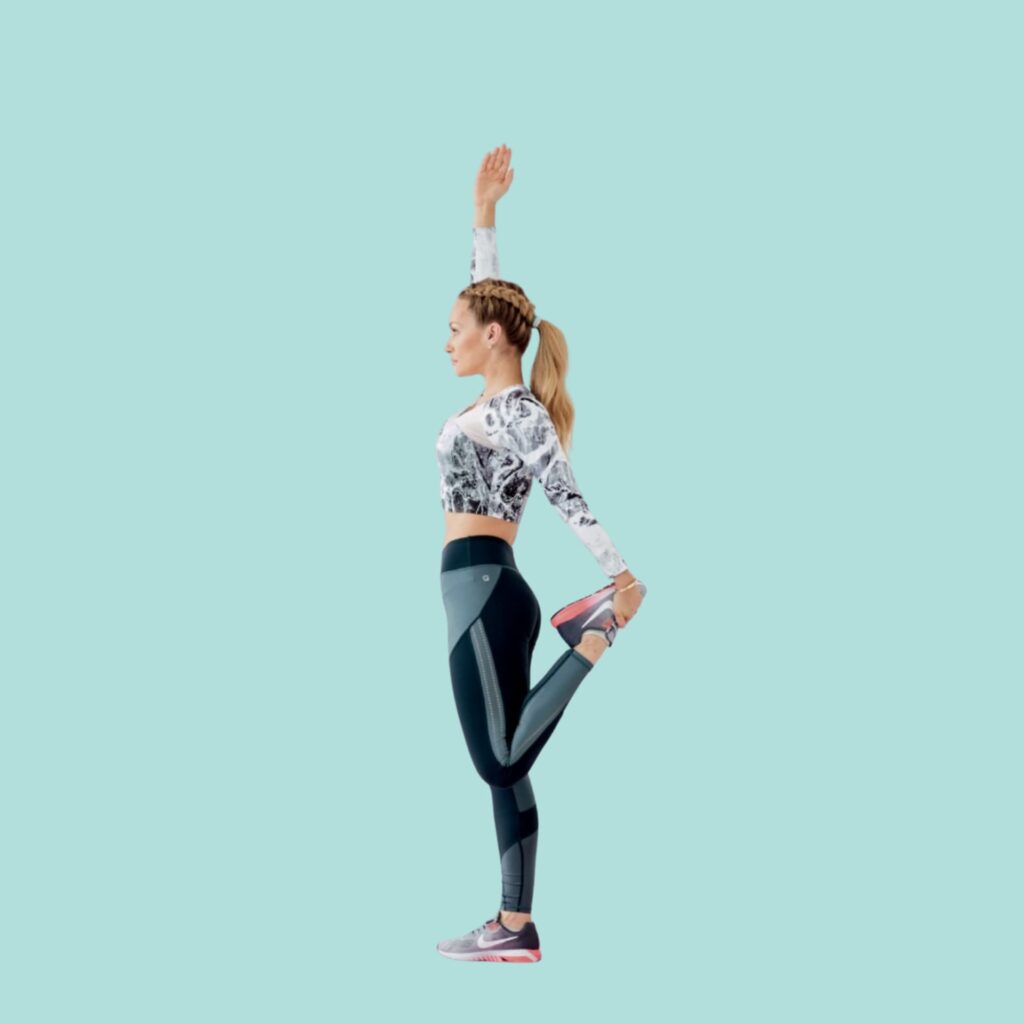
What is so great about the Standing quad stretch (left + right)? You can do this stretching exercise anywhere! Standing quad stretch (left + right) can be done in the office, in the gym, or before long run. If you find a place to stand, you can do a standing quad stretch.
Practiced regularly, this stretch can help you maintain or improve the range of motion. While the evidence is still debatable as to whether stretching prevents injuries in sports, Standing quad stretch (left + right) will often be included in exercise sessions. 1 2
How to do:
- Start standing with your feet together or Tadasana. Bend your left knee and bring your left ankle towards the bum. Clasp your ankle with left hand, use your right hand to keep balance.
- Push the left hip slightly forward so that you can begin to feel the stretch. Keep your knees together.
- Hold position 30 seconds and repeat on the opposite side.
SAFETY TIP: If you feel any severe pain, be sure to stop the stretch. See your physical therapist to make sure that you are doing the stretch properly.
7. Kneeling groin stretch (left and right stretch)
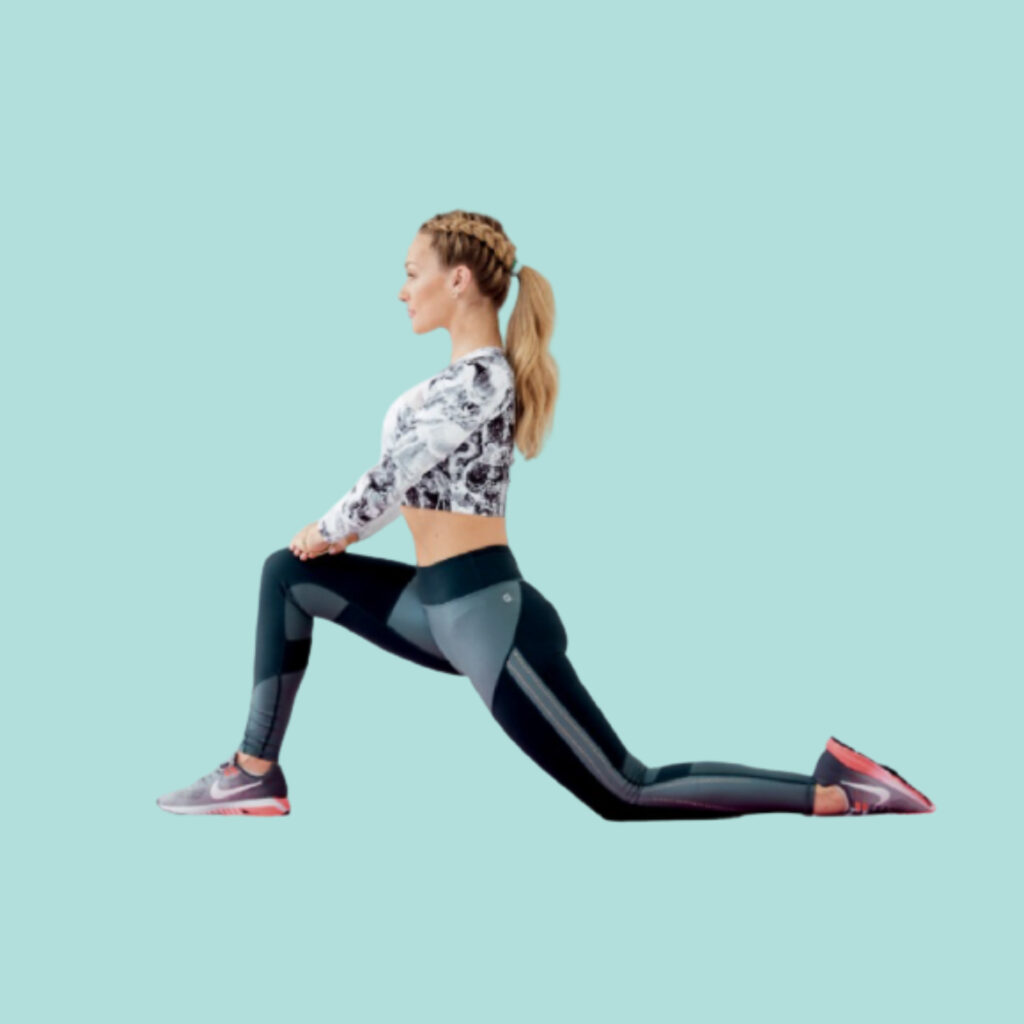
Kneeling groin stretch (left + right stretch) is a great way to stretch the hip flexors. An essential warm-up and cool-down exercise, Kneeling groin stretch (left + right stretch) will also do wonders for your posture.
How to do:
- Stand with your feet shoulder-width apart and take a large step forward with right leg. Allow left knee to come down to touch the floor. Your left shin and the top of left foot should be flat against the mat.
- Push your pelvis forward and hold 15-30 seconds, keeping your back straight.
- Release and repeat on the opposite side.
8. Low lunge (left and right)
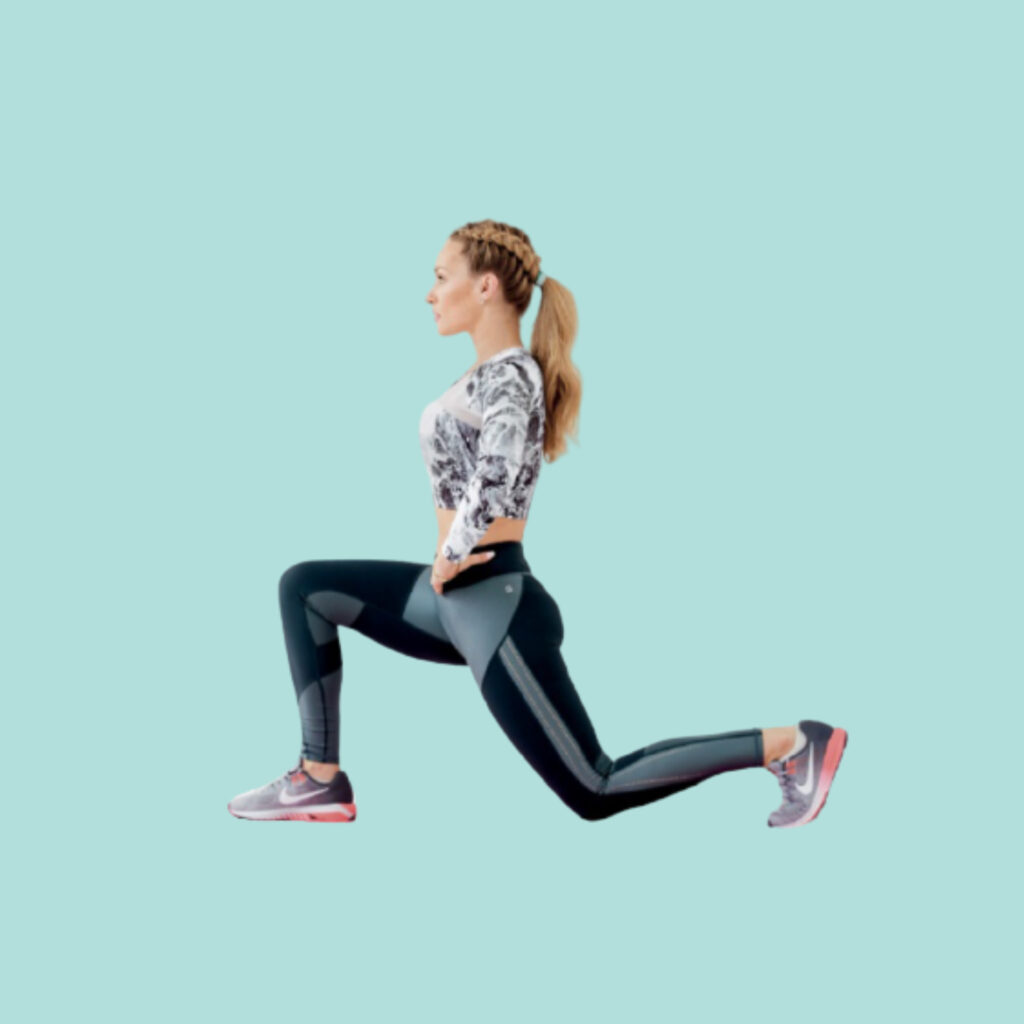
Low lunge, also known as Monkey lunge or Anjaneyasan, stretches the hips, gluteus muscles, and quadriceps during balance, concentration, and core awareness.
It demands a strong sense of balance combined with a certain degree in legs, hips and waist in a deceptively easy-looking package.
How to do:
- Begin in Downward Dog Pose. Exhale, step right foot forward. Lower yourself onto left knee.
- While inhaling, keep yourself upright with your spine straight.
- Exhale, bring the hands back to the floor. Slightly raise left knee to complete the stretch.
- Repeat on the opposite side.
9. Downward dog pose
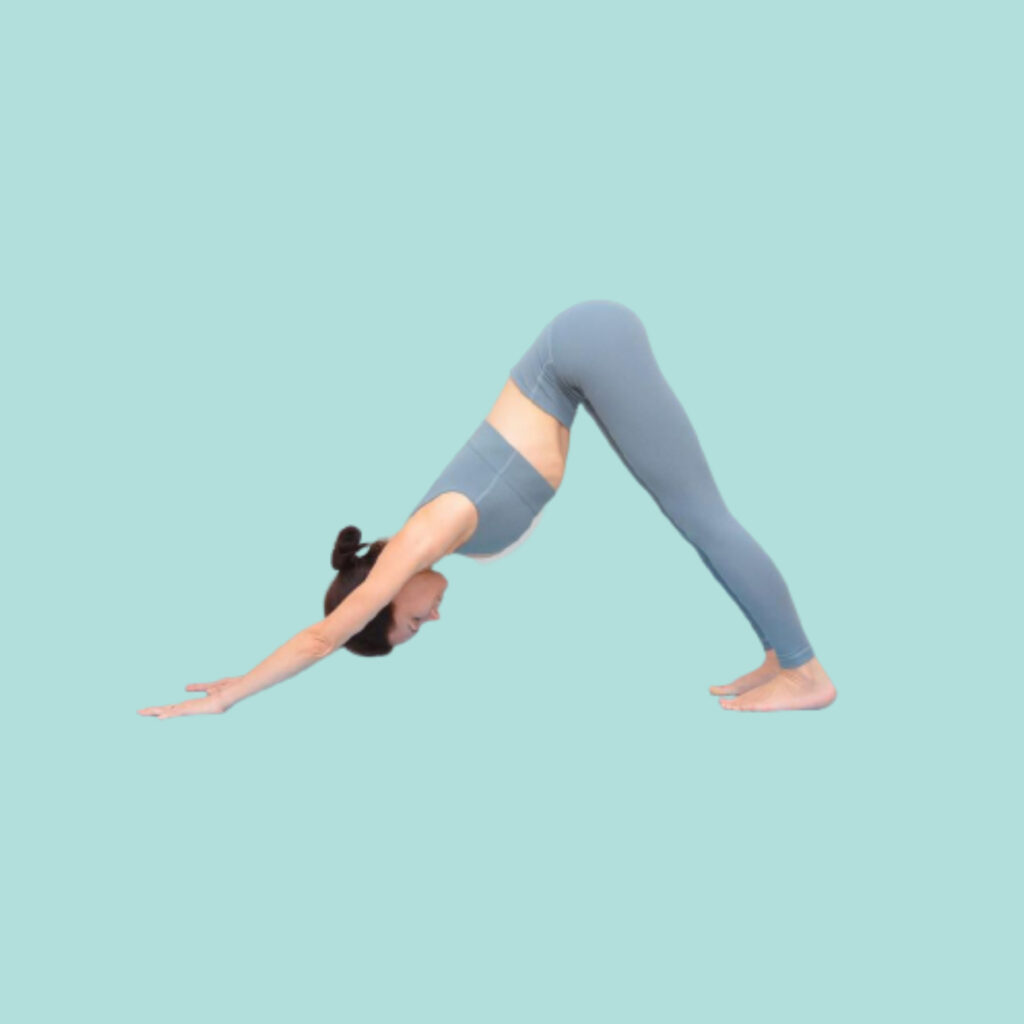
Downward dog pose has many benefits, can work any kink in your body and can bring blood flow to your brain. This stretching pose makes every muscle strong, lengthens and energetic. It is important to learn how to do the Downward dog stretch properly below so that you can actually reap all the rewards of the pose.
How to do:
- Start on hands and your knees. Exhale, push your pelvis towards the ceiling. Slowly begin to straighten the legs.
- Keep the arms extended and push away from the floor, lifting through pelvis. Your heels should be slightly raised.
- Hold for 15 to 20 seconds.
- To release, exhale and bend through the knees, bringing yourself back to the starting position.
10. Upward dog pose
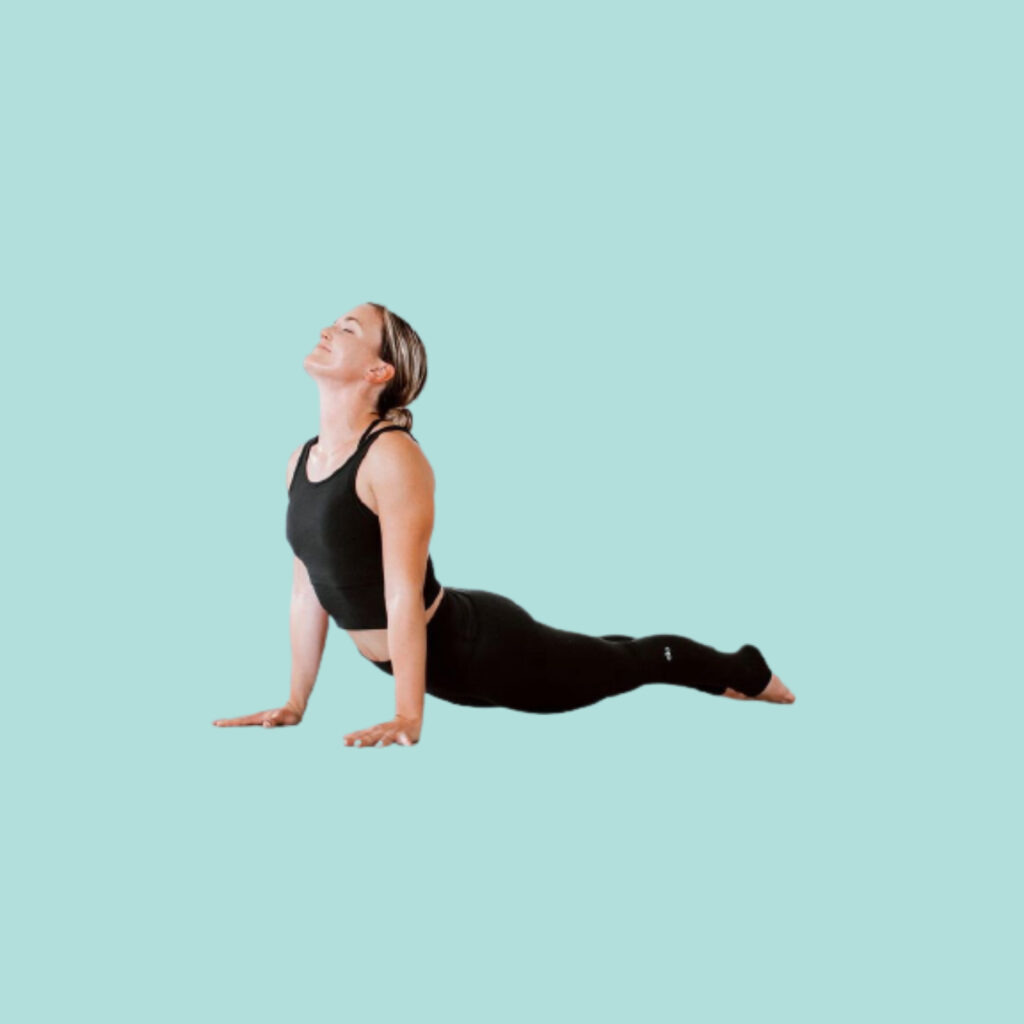
The Upward dog pose is a powerful pose that provides a wonderful stretch for the chest and abdomen and awakens the power of the upper body. This is one of the most common poses in Vinayasa flow sequencing, which of course means that it is even more important to correct it to prevent injury.
How to do:
- Start lying face-down on the floor. Bend your arms and bring hands face-down on the floor just above parallel to the waist.
- Inhale and press your hands firmly into the floor. Straighten your arms and lift your back, waist and tops of legs a few inches off the floor.
- Keep the bum firm but not tensed. Tip the head back slightly and hold for 30 seconds.
11. Pigeon pose (left and right)
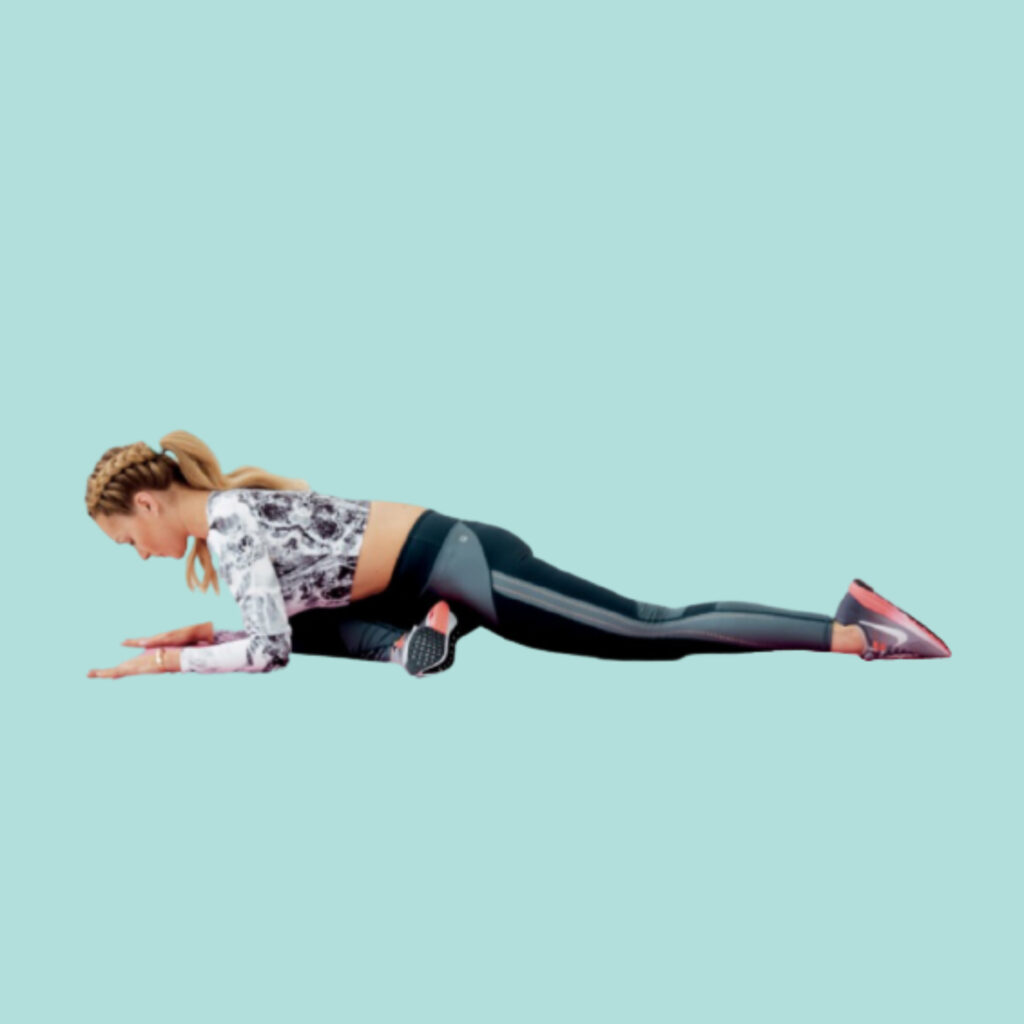
Pigeon pose (left and right) increases the outer range of motion of the femur in the hip socket, lengthens the hip flexors, prepares the body for the backbend and prepares the body for sitting postures such as the Padmasana (Lotus pose).
How to do:
- Start on hands and your knees. Bring right leg forward and cross below your body. Slide left leg back, keeping your knee to the ground.
- While exhaling, walk your hands forward and lower the upper body to the floor. Hold for 15–20 seconds.
- Push back through the hands and slowly release.
- Repeat on the opposite side.
TIP: To avoid injury, I first approach the pigeon by making changes that will open the hips slowly and safely. Once your hips are open, you will be able to craft a well-balanced pigeon that will benefit your hips and lower back. If you practice this continuously, you will see your half more easily as you sit, walk and stand.
12. Child’s pose (left and right stretch)
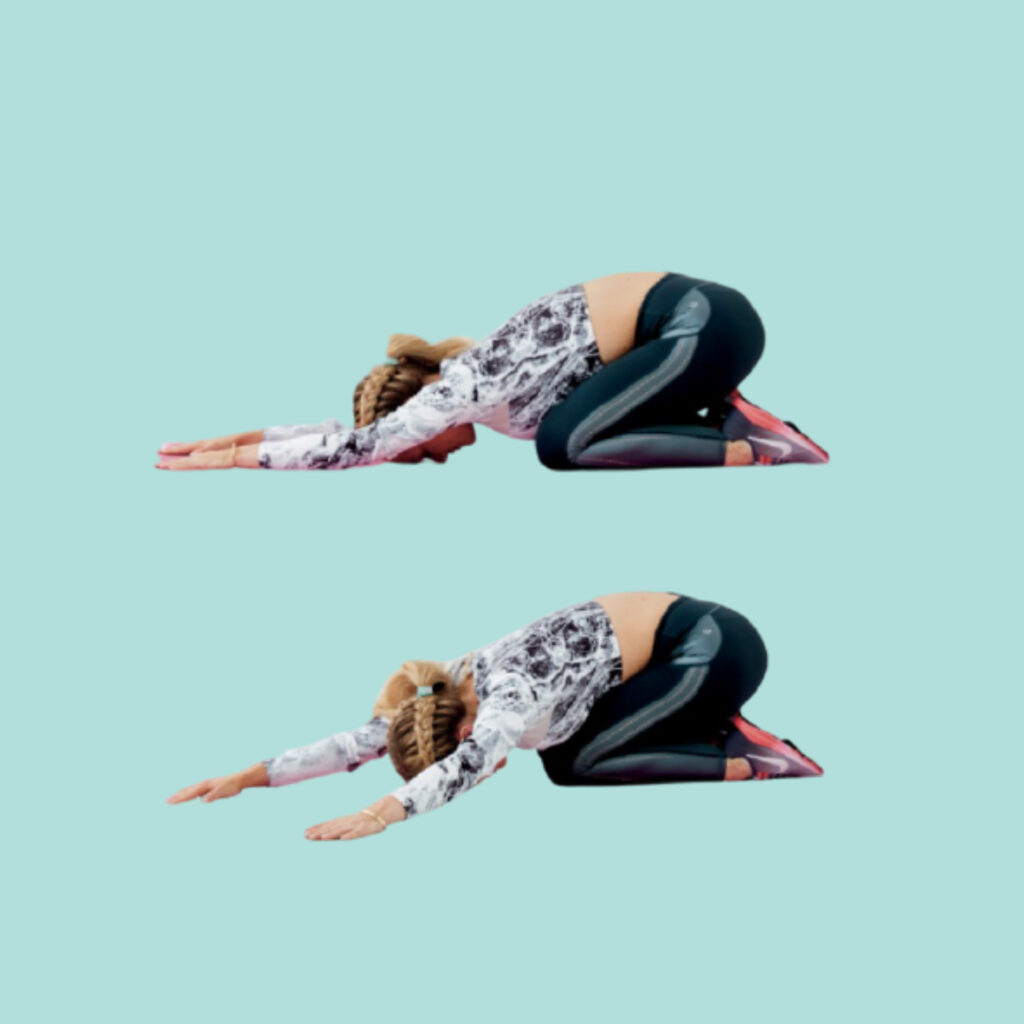
Child’s pose (left and right stretch) calms the body, mind and soul and stimulates the third eye point. Balasana (Child’s pose) gently pulls the low back, massages and tones the abdominal organs, and stimulates digestion and elimination.
How to do:
- Keeping your legs and pelvis aligned, pull the torso over to your left side, keeping arms and head in the same position.
- Repeat on the opposite side.
13. Head to knee (right, centre and left)
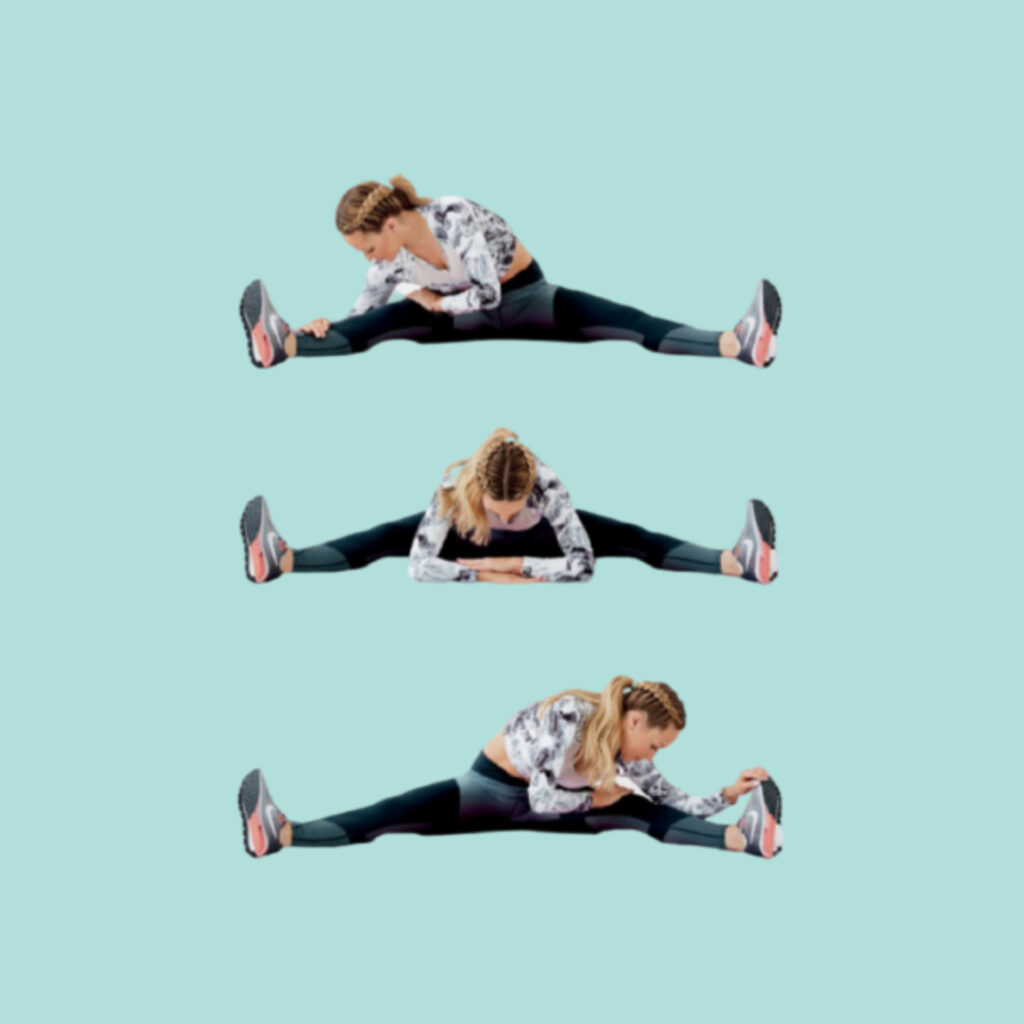
As a forward facing posture, the Head to knee pose is calm and comfortable, and can help with anxiety, insomnia, headaches, and mild depression. Physiologically, the Head to knee (right, centre and left) expands the spine, shoulders, hamstrings, and granules, stimulates the liver and kidneys, and also improves digestion.
How to do:
- Start by sitting on the floor with the legs stretched out open in front of you. Bring your torso over to the right knee and rest your arms on the right leg. Lower the head and sternum and hold for 1 minute, release and return to the starting position.
- Cross the arms and lower the head, sternum and torso straight in front of you pushing into the stretch. Hold for 1 minute and release, returning to the starting position.
- Repeat step 1 on your left side.
Bottom line
Incorporating stretching exercises into the workout schedule improves flexibility, reduces stiffness and ultimately makes workouts more efficient and safer. To help reduce muscle stretch and increase mobility, try adding stretching exercises before or after a workout for flexibility.
Stretching before your workout is good because it can make your body warm. It encourages the flow of blood to your muscles along side the extra oxygen and nutrients needed to drag through the workout. This prepares your body for further stress. Before the workout, we focus on dynamic stretching, where there is no stretching, but movement. The aim is to prepare the muscles and connective tissues for further workouts.
However, incorporating stretching exercises after your workout will give you additional benefits, as your body is already completely heated, which can actually strengthen your muscles, reducing the risk of injury. Therefore stretching exercises are also recommended after workouts, because then your muscles are already heated and filled with blood.
- Lee JH, Jang KM, Kim E, Rhim HC, Kim HD. “Static and Dynamic Quadriceps Stretching Exercises in Patients With Patellofemoral Pain: A Randomized Controlled Trial.” Sports Health. 2021 Sep-Oct;13(5):482-489. doi: 10.1177/1941738121993777. Epub 2021 Feb 20. PMID: 33615901; PMCID: PMC8404765.[↩]
- Page P. “Current concepts in muscle stretching for exercise and rehabilitation.” Int J Sports Phys Ther. 2012 Feb;7(1):109-19. PMID: 22319684; PMCID: PMC3273886. Available from: https://www.ncbi.nlm.nih.gov/pmc/articles/PMC3273886.[↩]


